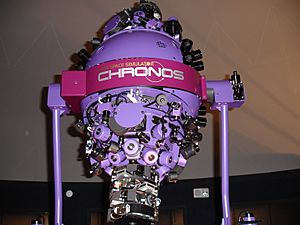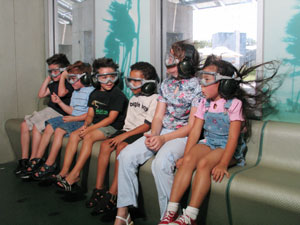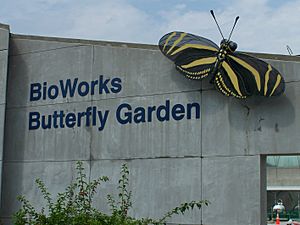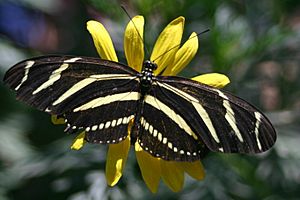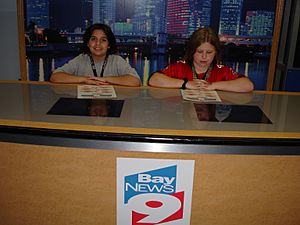- This page was last modified on 17 October 2025, at 10:18. Suggest an edit.
Museum of Science & Industry (Tampa) facts for kids
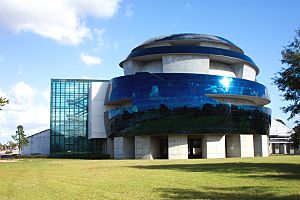
The Museum of Science & Industry's former IMAX theater
|
|
| Established | 1962 |
|---|---|
| Location | 4801 East Fowler Ave Tampa, Florida |
| Type | Science museum |
The Museum of Science & Industry (MOSI) is a fun and educational science museum in Tampa, Florida. It's a non-profit place, which means it's not run for money. MOSI gets its funding from donations, company sponsors, and support from Hillsborough County and the City of Tampa.
Contents
History of MOSI
MOSI started way back in 1962. That's when Hillsborough County first decided to fund a youth museum in Sulphur Springs. It was first called the Museum of Science and Natural History. It offered exhibits and learning programs about nature for kids and adults.
The museum's name changed to the Hillsborough County Museum in 1967. Later, in 1976, plans began for a new, bigger museum in North Tampa. This new building became the Museum of Science & Industry. It officially opened its doors to the public on January 23, 1982.
In 1995, a huge expansion was finished. This added 190,000 square feet of space. It included Florida's only IMAX Dome Theatre at the time. There were also many new exhibit areas, a planetarium, and a public library. MOSI became one of the largest science centers in the Southeast United States. More updates happened in 1996, 2001, and 2005.
To save money, MOSI made some changes on August 13, 2017. They closed about 85% of their building and the IMAX theater. Many exhibits were moved to a smaller area. In 2022, there were talks about building a new museum downtown. However, those plans changed. Instead, MOSI is now focusing on making its current location even better. They are adding new exhibits and programs.
Awards and Recognition
MOSI is a highly respected museum. In April 2008, it was re-accredited by the American Alliance of Museums (AAM). This means it meets high standards for museums. In 2009, MOSI received the National Medal for Museums. This is the highest national award given to museums in the U.S.
Awesome Educational Programs
MOSI offers many exciting S.T.E.A.M. programs. S.T.E.A.M. stands for Science, Technology, Engineering, Art, and Math. These programs are for students from preschool all the way through high school.
MOSI also has special camps when school is out. This includes fun summer educational camps. These camps explore many different science topics. You could learn about snorkeling in a natural spring. You might even use DNA to solve pretend crimes. Or, you could design your own video games! After finishing a camp, attendees get a S.T.E.A.M. Certificate of Achievement.
Connecting with the Community
Hispanic Scientist of the Year Award
Tampa Bay has a very diverse community. MOSI celebrates this by honoring Hispanic Scientists each year. They give out the Hispanic Scientist of the Year Award. This award has been given since 2001. These scientists visit MOSI for "Meet the Scientists Days." They talk to kids about how they got into science, technology, engineering, and math (STEM) fields.
Current Exhibits to Explore
Mission: Moonbase
Imagine living on the Moon in the year 2070! That's what Mission: Moonbase is all about. It's a simulated lunar base. It's built near the Moon's south pole. Scientists believe there's lots of frozen water there. This water can be used for future moon missions. Moonbase is the main control center. It also helps with growing food and mining on the Moon. NASA helped fund Mission: Moonbase at MOSI. It helps MOSI keep improving and supporting the future of S.T.E.A.M. learning.
Slippery Science
Slippery Science is an interactive exhibit. It has many parts that teach you about friction and physics. You can learn about how fast you react to things. The exhibit even has elements from the Tampa Bay Lightning hockey team!
Dinovations Lab
Step back in time at the Dinovations Lab! This exhibit is all about dinosaurs and paleontology. Paleontology is the study of ancient life. You can do PaleoLab investigations. There are crawl-through challenges. You can also watch dino-themed animations in Fossil Films. And yes, you can even touch actual dino poop!
Saunders Planetarium
The Saunders Planetarium opened in 1992. It is currently the only planetarium in Tampa. A planetarium is a theater that shows you the stars and planets. Thanks to a gift from the Saunders Foundation, it opened on October 3, 1992. In July 2009, the planetarium moved to a new spot inside the "Kids In Charge!" section. Since then, hundreds of thousands of people have enjoyed its shows.
Former Exhibits (No Longer at MOSI)
Gulf Coast Hurricane
This exhibit let people feel winds from a gentle rainstorm up to a category one hurricane. It taught visitors about how strong storms can be. The museum wanted people to "Get Smart, Get Ready" for storms. A chart showed the Beaufort Wind Scale as the wind increased. It explained what to expect at different wind speeds. For example, you couldn't hold an umbrella at 25 miles per hour! The wind was made using recycled air. The strongest winds reached 74 miles per hour.
Bio-Works Butterfly Garden
The Bio-Works Butterfly Garden was added in 1996. It had a beautiful butterfly garden and a self-sustaining fish pond. The garden was home to over 30 types of butterflies. Most of these were native to Florida. Thousands of native Florida butterflies were raised each year in a lab you could see. These included the zebra longwing, which is Florida's state butterfly. Also, the giant swallowtail and tiger swallowtail, two of North America's largest butterflies.
The pond and tanks were part of a model wastewater treatment system. It cleaned wastewater in a simulated wetland. The clean water then went into a fish pond. The fish in the pond included tilapia. These tilapia were special. They were descendants of the first fish born in space! This fish, named Amigo, was born during John Glenn's last space mission, STS-95. It was brought back to Earth to study its reproduction.
The Amazing You!
This exhibit was about health and wellness for all ages. It showed how to stay healthy at different stages of life. It also explained how to recover after an illness or injury. It was a large exhibit, covering 13,000 square feet. The first part focused on life from birth to teenage years. The second part covered young adulthood to older ages.
WeatherQuest Sponsored by Bay News 9
WeatherQuest was an exhibit inside "Disasterville." It featured a Bay News 9 news desk and a meteorologist green screen. This exhibit had 10,000 square feet of interactive displays. It taught about the science of natural disasters. It also showed how disasters affect people and property. Most importantly, it taught what you can do to stay safe. The exhibit covered nine types of disasters. These included floods, hail storms, hurricanes, lightning, tornadoes, wildfires, volcanoes, earthquakes, and tsunamis.

